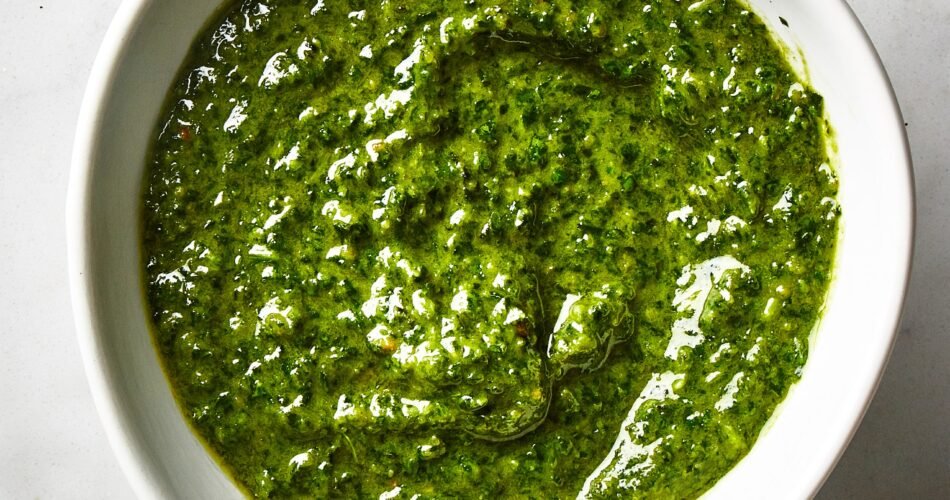What does pesto taste like? This is a question I’ve heard time and again, from friends and family members who’ve observed the hype but haven’t tasted it for themselves. It’s an intriguing question, considering that pesto has become a staple in kitchen pantries worldwide.
What Does Pesto Taste Like? The Answer
To describe what pesto tastes like in the simplest of terms, I would say it’s like a vibrant garden party in your mouth. The primary flavor comes from the fresh basil—herbal and slightly sweet—paired with the rich, nutty flavor of pine nuts. There’s a lovely sharpness from the garlic and a tangy kick from the Parmesan cheese, all brought together by the smooth and fruity olive oil. The result? A complex, flavorful sauce that’s bold yet balanced, with each ingredient complementing the other.
People often wonder what pesto tastes like because it’s a sauce that boasts a unique profile, quite unlike your typical tomato or cream-based sauces. The distinctive green color and thick texture lead to curiosity about its flavor profile, as does its versatility in various dishes. Pesto seems to be a culinary chameleon, so it’s natural to question how it will affect the overall taste of a meal.

Variations in Taste of Pesto
The flavor of pesto can differ based on regional recipes and local ingredients. For instance, the classic Italian basil pesto, or Pesto alla Genovese, hails from Genoa and follows a traditional recipe. Yet, venture to other parts of Italy or the globe, and you’ll find interesting twists like using different nuts such as walnuts or almonds or incorporating other greens, such as kale or arugula, which changes the taste accordingly. These small tweaks can impart subtle differences, creating a range of pesto flavors to explore.
Seasonality can also influence the taste of pesto. Fresh basil picked in the summer, at its peak, will give pesto a more vibrant and potent flavor compared to basil grown off-season in greenhouses. Different basil cultivars can have varied tastes as well, and whether the nuts used are toasted or not can also add another layer of flavor complexity to pesto.
Nutritional Benefits of Pesto & Impact on Taste
Pesto is not only delicious but also packed with nutritional benefits. It’s rich in unsaturated fats thanks to olive oil and nuts, which are good for heart health. The fresh basil provides valuable antioxidants and antibacterial properties, while the Parmesan cheese adds protein and calcium to the mix—each healthful ingredient contributing to pesto’s indulgent taste.
The health aspects of pesto might influence one’s perceptions of taste, knowing that something so creamy and flavorful is also beneficial makes the sauce all the more enjoyable. For health-conscious individuals, the association of pesto with vitality might make every bite taste just a little bit more vibrant and gratifying.
:max_bytes(150000):strip_icc()/23134-PestoSauce-MFS-2X3-0243-8ae60aca21734c55b9c506a979ce0b8a.jpg)
Pesto in Culinary Uses
Pesto is incredibly versatile, often used as a sauce for pasta, a spread on sandwiches, or a dressing for salads. The savory and herbal flavors of pesto enhance the taste of simple dishes like grilled chicken or roasted vegetables. Pesto’s ability to complement a wide array of cuisines makes it a beloved addition to any cook’s repertoire.
When incorporated into recipes, pesto’s flavor melds beautifully with other ingredients. It brings out the sweetness in tomatoes, complements the earthy notes of mushrooms, and elevates the creaminess of mozzarella cheese in a Caprese salad. The herbaceous quality of the sauce also offers a counterbalance to rich and hearty dishes.
Acquiring and Preparing Pesto
You’ll find ready-made pesto in most grocery stores, usually near other sauces or in the refrigerated section. When shopping for pesto, look for vibrant green color and fresh ingredients. You can also prepare it at home with fresh basil leaves, pine nuts, garlic, Parmesan cheese, and a good quality extra-virgin olive oil to fully control the flavor.
For an enhanced flavor experience, pair pesto with complementary ingredients. Drizzle it over freshly baked bread, blend it with cream for a rich pasta sauce, or mix it into a vinaigrette for a zesty salad dressing. The versatility of pesto leaves room for culinary creativity and the opportunity to tailor its flavor to your liking.
:max_bytes(150000):strip_icc()/__opt__aboutcom__coeus__resources__content_migration__simply_recipes__uploads__2014__08__Fresh-Basil-Pesto-LEAD-2-d990e7900183450dbddb69628bd8a160.jpg)
Final Words
In summary, what does pesto taste like? It tastes like a harmonious blend of fresh basil, toasty nuts, sharp garlic, tangy cheese, and smooth olive oil. It’s rich, it’s savory, and it’s incredibly versatile. The true beauty of pesto’s taste lies in its freshness and high-quality ingredients, paired with its ability to make a simple dish come to life. Whether you’re a culinary expert or just love good food, pesto is bound to be an intriguing and enjoyable flavor adventure.

